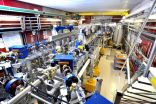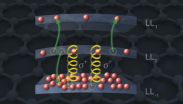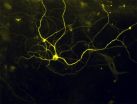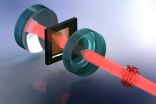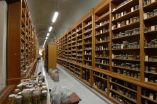(Press-News.org) Scientists at the Helmholtz-Zentrum Dresden-Rossendorf (HZDR) have studied the dynamics of electrons from the "wonder material" graphene in a magnetic field for the first time. This led to the discovery of a seemingly paradoxical phenomenon in the material. Its understanding could make a new type of laser possible in the future. Together with researchers from Berlin, France, the Czech Republic and the United States, the scientists precisely described their observations in a model and have now published their findings in the scientific journal Nature Physics.
Graphene is considered a "wonder material": its breaking strength is higher than steel and it conducts electricity and heat more effectively than copper. As a two-dimensional structure consisting of only a single layer of carbon atoms, it is also flexible, nearly transparent and approximately one million times thinner than a sheet of paper. Furthermore, shortly after its discovery ten years ago, scientists recognized that the energy states of graphene in a magnetic field - known as Landau levels - behave differently than those of semiconductors. "Many fascinating effects have been discovered with graphene in magnetic fields, but the dynamics of electrons have never been studied in such a system until now," explains physicist Dr. Stephan Winnerl from HZDR.
The HZDR researchers exposed the graphene to a four-Tesla magnetic field - forty times stronger than a horseshoe magnet. As a result, the electrons in graphene occupy only certain energy states. The negatively charged particles were virtually forced on tracks. These energy levels were then examined with free-electron laser light pulses at the HZDR. "The laser pulse excites the electrons into a certain Landau level. A temporally delayed pulse then probes how the system evolves," explains Martin Mittendorff, doctoral candidate at the HZDR and first author of the paper.
Electron redistribution surprises scientists
The result of the experiments has astonished the researchers. This particular energy level, into which new electrons were pumped using the laser, gradually emptied. Winnerl illustrates this paradoxical effect using an everyday example: "Imagine a librarian sorting books on a bookshelf with three shelves. She places one book at a time from the lower shelf onto the middle shelf. Her son is simultaneously 'helping' by taking two books from the middle shelf, placing one of them on the top shelf, the other on the bottom. The son is very eager and now the number of books on the middle shelf decreases even though this is precisely the shelf his mother wishes to fill."
Because there were neither experiments nor theories regarding such dynamics before, the Dresden physicists initially had difficulty interpreting the signals correctly. After a number of attempts, however, they found an explanation: collisions between electrons cause this unusual rearrangement. "This effect has long been known as Auger scattering, but no one expected it would be so strong and would cause an energy level to become depleted," explains Winnerl.
This new discovery could be used in the future for developing a laser that can produce light with arbitrarily adjustable wavelengths in the infrared and terahertz ranges. "Such a Landau-level laser was long considered impossible, but now with graphene this semiconductor physicists' dream could become a reality," says Winnerl enthusiastically.
Berlin researchers calculate complex model for Dresden experiments
After the fundamental model used in the experiments had worked satisfactorily, the precise theoretical work followed, which was carried out at the Technical University Berlin. Berlin scientists Ermin Malic and Andreas Knorr confirmed, using complex calculations, the Dresden group's assumptions and provided detailed insights into the underlying mechanisms. The HZDR researchers additionally cooperated with the French High Magnetic Field Laboratory in Grenoble (Laboratoire National des Champs Magnétiques Intenses - LNCMI), the Charles University Prague and the Georgia Institute of Technology in Atlanta (USA).
INFORMATION:
The research has been funded by the German research association DFG (Deutsche Forschungsgemeinschaft) within the program "Graphene".
Publication: Martin Mittendorff, Stephan Winnerl et al.: „Carrier dynamics in Landau quantized graphene featuring strong Auger scattering", Nature Physics, in press, DOI: 10.1038/NPHYS3164
Further Information:
Stephan Winnerl
Institute of Ion Beam Physics and Materials Research at the HZDR
Phone: +49 351 260-3522
s.winnerl@hzdr.de
Media Contact:
Christine Bohnet | Press Officer
Phone: +49 351 260 2450 | Mobile: +49 160 969 288 56 | c.bohnet@hzdr.de | http://www.hzdr.de
Helmholtz-Zentrum Dresden-Rossendorf | Bautzner Landstr. 400 | 01328 Dresden
The Helmholtz-Zentrum Dresden-Rossendorf (HZDR) conducts research in the sectors energy, health, and matter. It focuses its research on the following topics:
How can energy and resources be used efficiently, safely, and sustainably?
How can malignant tumors be visualized and characterized more precisely and treated effectively?
How do matter and materials behave in strong fields and at the smallest dimensions?
To answer these scientific questions, several large-scale research facilities provide unique research opportunities. These facilities are also accessible to external users.
The HZDR has been a member of the Helmholtz Association, Germany's largest research organization, since 2011. It has four locations in Dresden, Leipzig, Freiberg, and Grenoble and employs about 1,000 people - approx. 500 of whom are scientists including 150 doctoral candidates.
Boston, MA - Researchers at Harvard School of Public Health (HSPH) have found a novel mechanism causing type 2 diabetes that could be targeted to prevent or treat the disease. The research highlights a previously unrecognized molecular pathway that contributes to the malfunction of liver cells in obesity, leading to insulin resistance and diabetes.
The study appears online November 24, 2014 in Nature Medicine.
"While it is well-established that obesity generates cellular and molecular stress leading to abnormal functioning of many cellular processes, the mechanisms ...
CAMBRIDGE, MA -- Researchers have made great progress in recent years in the design and creation of biological circuits -- systems that, like electronic circuits, can take a number of different inputs and deliver a particular kind of output. But while individual components of such biological circuits can have precise and predictable responses, those outcomes become less predictable as more such elements are combined.
A team of researchers at MIT has now come up with a way of greatly reducing that unpredictability, introducing a device that could ultimately allow such ...
After more than six years of intensive effort, and repeated failures that made the quest at times seem futile, Harvard Stem Cell Institute (HSCI) researchers at Boston Children's Hospital (BCH) and Harvard's Department of Stem Cell and Regenerative Biology (HSCRB) have successfully converted mouse and human skin cells into pain sensing neurons that respond to a number of stimuli that cause acute and inflammatory pain.
This "disease in a dish" model of pain reception may advance the understanding of different types of pain, identify why individuals differ in their pain ...
Cloaking immune cells with antibodies that block T cell trafficking to the gut can substantially reduce the risk of viral transmission in a non-human primate model of HIV infection, scientists report.
The findings suggest that drugs that are already in clinical trials for inflammatory bowel diseases might be effective in the treatment or prevention of HIV infection.
The results are scheduled for publication in Nature Medicine.
"We were surprised by the effects that we observed," says senior author Aftab Ansari, PhD, professor of pathology and laboratory ...
It's a dog eat dog world, and bacteria have been living in it for a long time. It's of no surprise that bacteria have a sophisticated arsenal to compete with each other for valuable resources in the environment. In 2010, work led by University of Washington Department of Microbiology Associate Professor Joseph Mougous uncovered a weaponry system used in this warfare between bacteria. The combatants inject deadly toxins into rival cells.
Now, in a surprising twist, Mougous and colleagues have found that many animals have taken a page from the bacterial playbook. They steal ...
EAST LANSING, Mich. --- What will it take to convince skeptics of global warming that the phenomenon is real? Surely, many scientists believe, enough droughts, floods and heat waves will begin to change minds.
But a new study led by a Michigan State University scholar throws cold water on that theory.
Only 35 percent of U.S. citizens believe global warming was the main cause of the abnormally high temperatures during the winter of 2012, Aaron M. McCright and colleagues report in a paper published online today in the journal Nature Climate Change.
"Many people already ...
Physicists at the University of Basel have developed a new cooling technique for mechanical quantum systems. Using an ultracold atomic gas, the vibrations of a membrane were cooled down to less than 1 degree above absolute zero. This technique may enable novel studies of quantum physics and precision measurement devices, as the researchers report in the journal Nature Nanotechnology.
Ultracold atomic gases are among the coldest objects in existence. Laser beams can be used to trap atoms inside a vacuum chamber and slow down their motion to a crawl, reaching temperatures ...
Are Italian natural history museums (NHMs) on the verge of collapse? A new analysis published in the open access journal ZooKeys points out that these institutions are facing a critical situation due to progressive loss of scientific relevance, decreasing economic investments and scarcity of personnel.
The study proposes that existing museums associate and collaborate to form a diffused structure, able to better manage their scientific collections and share resources and personnel.
"Italy is universally known for its history, culture, food and art. The list of Italian ...
Scientists from Uppsala University, the Science for Life Laboratory (SciLifeLab) in Stockholm and Uppsala University Hospital have developed a new method of rapidly identifying which bacteria are causing an infection and determining whether they are resistant or sensitive to antibiotics. The findings are now being published in the Journal of Clinical Microbiology.
'Clinical use of the method would mean that the right antibiotic treatment could be started straightaway, reducing unnecessary use of antibiotics,' says Professor Dan I. Andersson of Uppsala University, who ...
HOUSTON - (Nov. 24, 2014) - New computer models that show how microtubules age are the first to match experimental results and help explain the dynamic processes behind an essential component of every living cell, according to Rice University scientists.
The results could help scientists fine-tune medications that manipulate microtubules to treat cancer and other diseases. Rice theoretical biophysicist Anatoly Kolomeisky and postdoctoral researcher Xin Li reported their results in the Journal of Physical Chemistry B.
Microtubules are cylinders made of 13 protein strands ...
